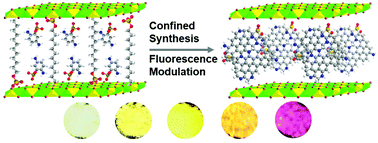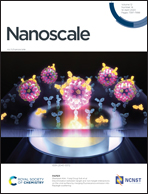Confined synthesis of carbon dots with tunable long-wavelength emission in a 2-dimensional layered double hydroxide matrix†
Abstract
Fluorescent carbon dots (CDs) have drawn significant attention due to their variable species and intriguing optical properties; however, spectrally tuning the fluorescence color of CDs, especially in a long-wavelength region, is still a challenge. In this study, CDs were synthesized through the hydrothermal reaction of 2,5-diaminobenzenesulfonate (DBS) and dodecyl sulfate (DS) in the confined interlayer space of layered double hydroxides (LDHs). Particularly, the emission color of the obtained CD/LDH phosphors could be spectrally tuned from greenish-yellow (λem = 537 nm) to red (λem = 597 nm) by simply changing the molar ratio of the intercalated DBS and DS. Through the detailed characterization of different interlayer CDs by Fourier transform infrared spectroscopy (FTIR), Raman spectroscopy, elemental analysis, and X-ray photoelectron spectroscopy (XPS), a new route of modulating the absorption and emission wavelengths of CDs by regulating the content of graphitic nitrogen during heteroatom doping is presented. In addition, the stabilities of the solid-state luminescence against UV bleaching and temperature variation were improved by the rigid 2-dimensional (2D) LDH matrix, and prospective applications of the proposed CD/LDH phosphors were demonstrated in multicolour displays and in the fabrication of white light-emitting diodes (WLEDs).



 Please wait while we load your content...
Please wait while we load your content...